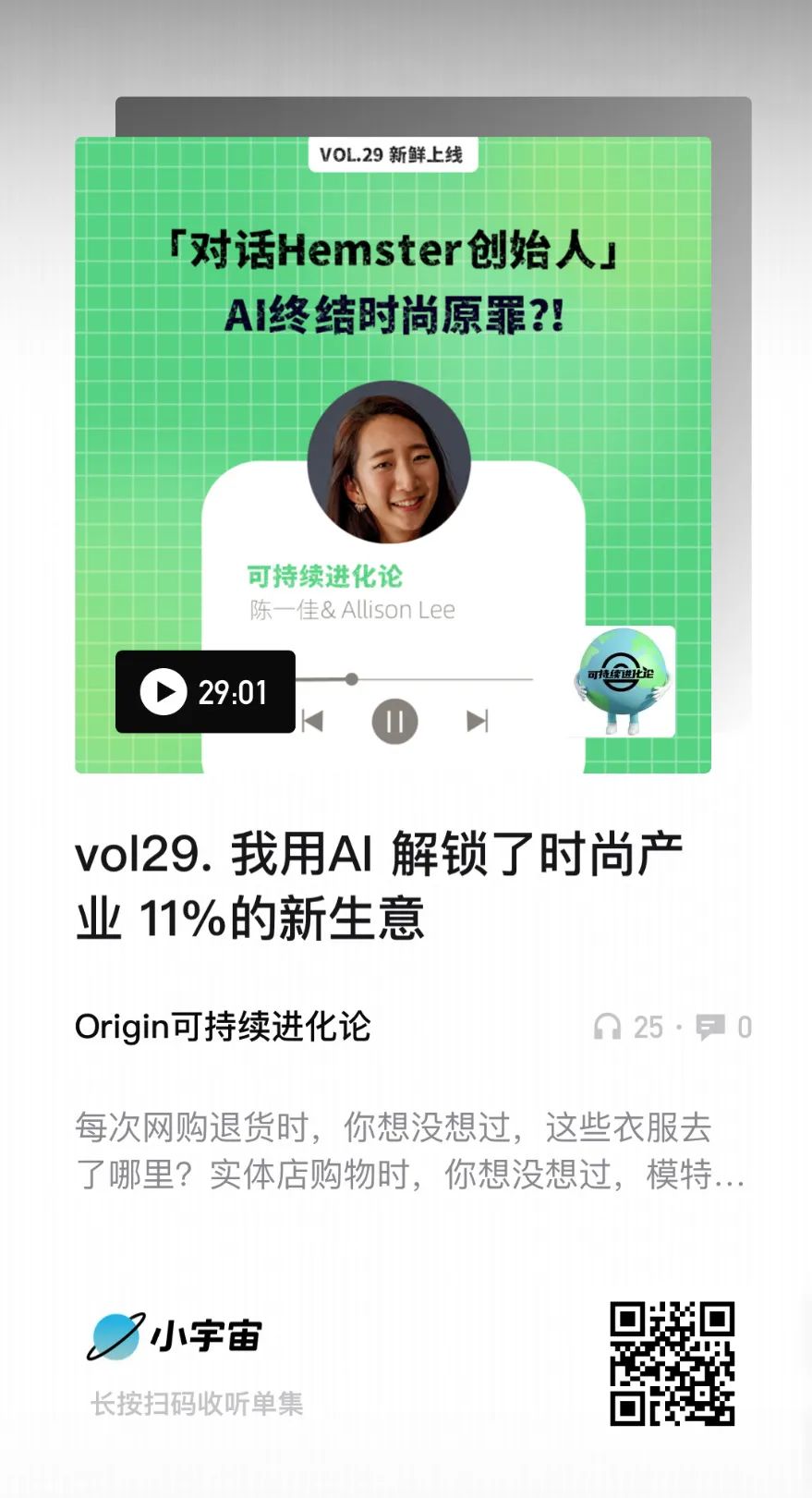
各大播客平台,
搜索“Origin研究所”或“陈一佳”,
即刻收听??
—总第29期—
「关于嘉宾」
Allison Lee
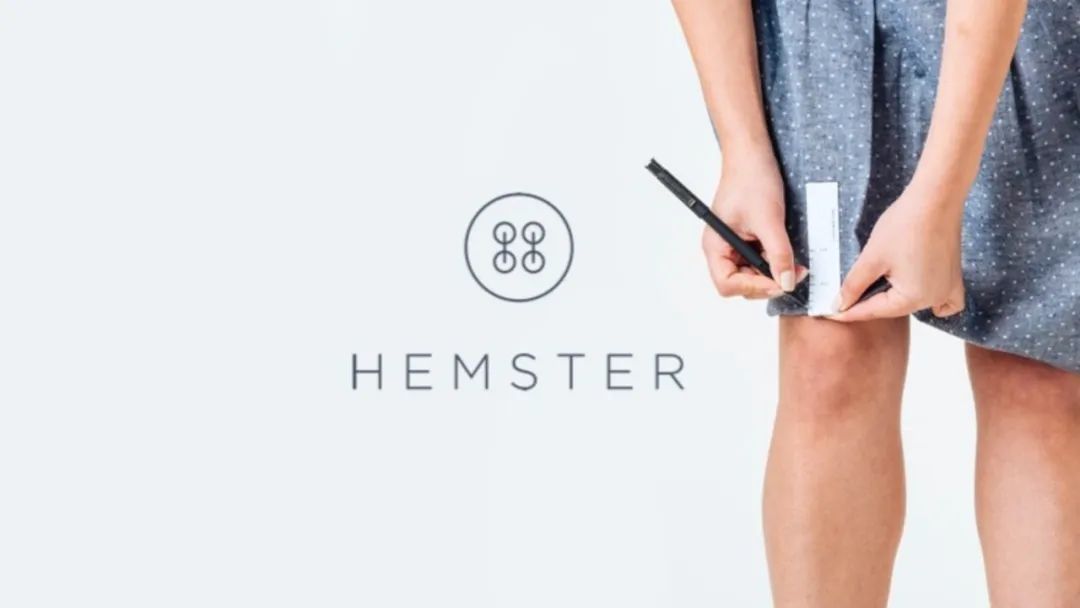
「阅读看点」
卖不出去的衣服去哪了?
给衣服拍照,一键翻新就这么简单!
为何H&M会拒绝衣服翻新?
新时代裁缝都是这么工作的
时尚圈喜欢扔衣服 是被政策“宠”坏了?
如何在老行业里发现新商机
翻新衣时尚:怎样让消费者爱上官方“二手”
「卖不出去的衣服去哪了?」

你能告诉我们服装行业每年产生多少浪费吗?
浪费的数量很惊人,因为时尚的各个环节,包括制造、设计、都容易造成不必要垃圾。比方说,有人在布料上剪下一个图案,但是剩下的布料就不能做其他东西了。所以所有的残片基本上都变成了不必要的垃圾。而成为成衣之后,这种浪费还会变得更大,比方说,成衣进入不同销售渠道,当你在商店里买东西,或者你从网上买了东西然后退货时,很多原因造成很多成衣在销售过程中是无法最终销售的。有研究显示,大约11%的成衣,实际上“过早”地进入了垃圾填埋场。“过早”的意思是,就因为一点很小的损坏,它真的直接从工厂进入到了垃圾填埋场。
现在市场是怎样处理破损和退回衣物的?
目前,品牌有四种不同的方式来处理。一个是回收,因为这些材料很多可能是合成的,你不能真正分成不同的纤维去回收。所以当我们说到回收,尤其是服装这一块,其实就只是把它撕碎,但它不会作为衣服被真正意义的回收,这是最主要的一块处理方式,也是最简单的处理方法。另一方面,他们会说,我要捐掉,但是如果你捐赠的是损坏的衣服,那是不能穿的,那么所有这些衣服,当它被捐赠中心收到时,大概率还是会被扔掉,因为捐赠机构没有资源来修复它。所以所谓的捐赠实际上不过是一种美化的说法。
然后,如果是奢侈品牌,他们真的很在乎品牌资产,他们不想让自己的二手产品充斥市场,那么一些品牌会决定毁掉残次品,甚至在工厂里就处理掉。第四个,也是最常见的,就是把成衣废品卖给国外的进口商。这就是隐藏在品牌损益表上的收入项目,尽管他们实际上是在亏损销售的。所以是有很多处理方式的,尤其是到海外,很普遍。很多衣服就会被送到肯尼亚这样的地方,但没有人真正回收它们,也没有人穿它们。基本上,就是变成一座二手服装的山。但很多发展中国家现在回应,我们不想再进口这些衣物了,因为我们也没有地方放它们了。
这些成衣废品对环境有什么样的影响?
就是我们看到的巨大的衣服山,这些衣服基本上最后都被填埋了,因为也不能被生物降解。
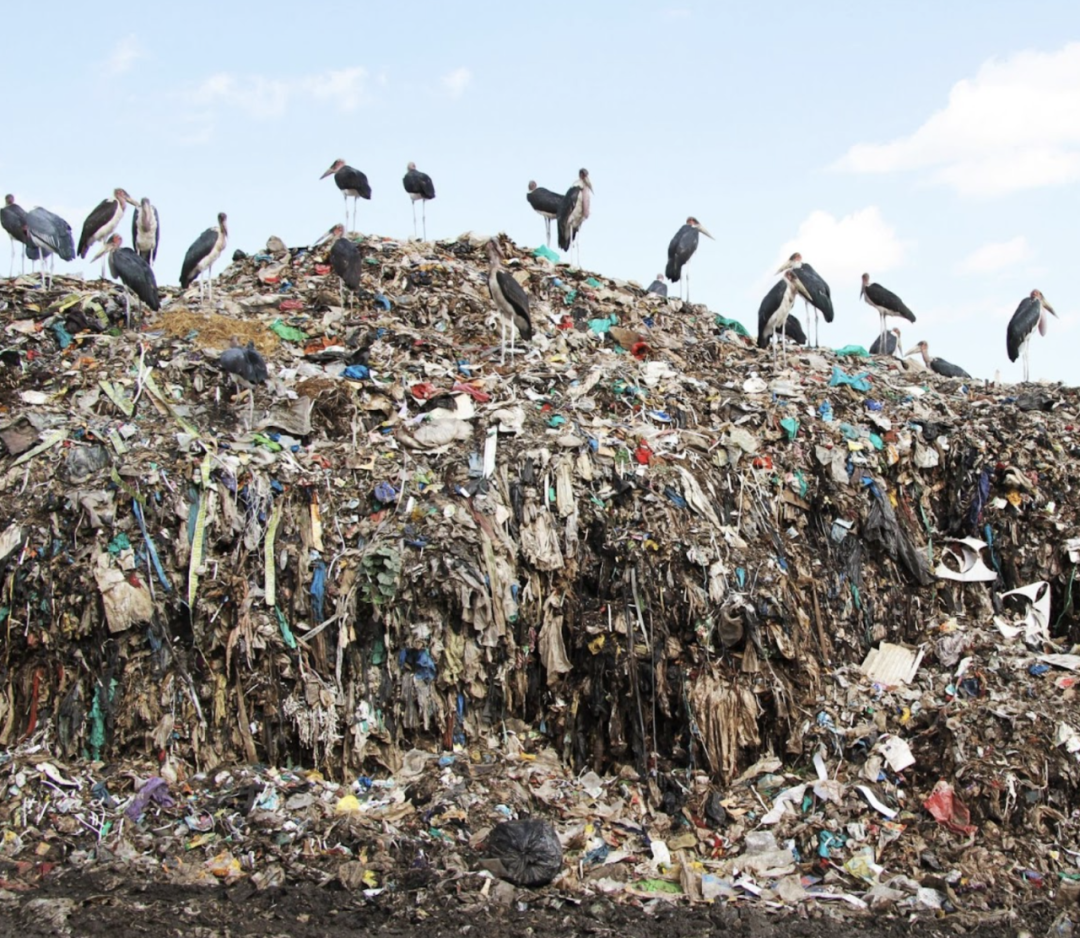
「给衣服拍照,一键翻新就这么简单!」
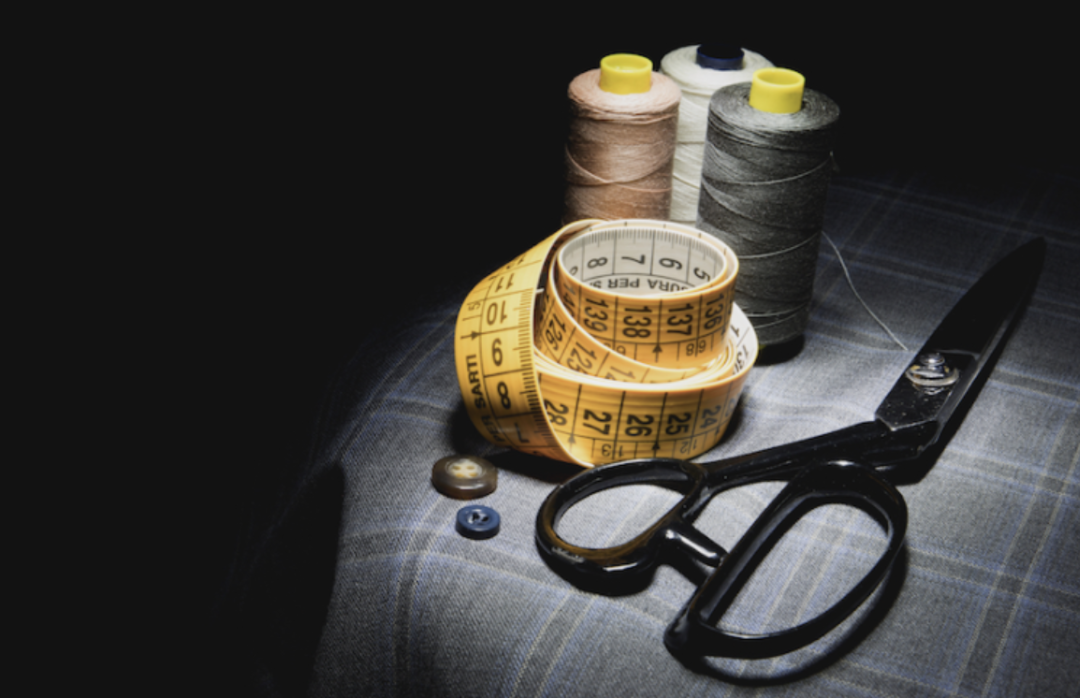
我知道你想要解决这个问题,跟我们介绍一下Hemster吧?
是的。当我们研究这个问题时,我认为主要有两个挑战。首先对于品牌来说,由于积压的库存没有被数据化录入,所以仓库的人根本不知道被退回的商品有什么问题。于是我们用一种由人工智能驱动的检索工具来帮助他们,不需要接受任何服装检索方面的培训,仓库里的任何工作人员都可以用我们的应用程序,给这些库存的衣服拍照。我们的应用程序就会像图像识别一样,通过对比,准确地识别出这件衣服的问题。比如说,原图有腰带,但这件没有腰带。那另一个挑战是,品牌想知道,我花额外的钱去翻新衣服,值吗?针对这个问题,我们构建了人工智能逻辑树。上面显示,这件衣服的建议零售价是多少,比如200美元,但现在是淡季,所以要打七折。另外,如果我们要在Poshmark(二手平台)上卖,那么得再额外打八折,所以我可以从一开始就计算出这件衣服的售价,然后跟品牌的翻新成本做比较,只有当利润率有意义时,我们才会继续提供接下来的翻新服务。这样一来,我们就保护了品牌的利润。
有意思的是,即使品牌的预算非常严格,到我们这里的高达92%的产品,还是会被批准修复,这说明它们都是一些非常小的损坏,品牌花钱不会超过30到40美元,就可以让它们重新翻新成为可销售的商品。所以翻新必须给品牌带来真正的利润,这也是可持续发展面临的最大挑战。
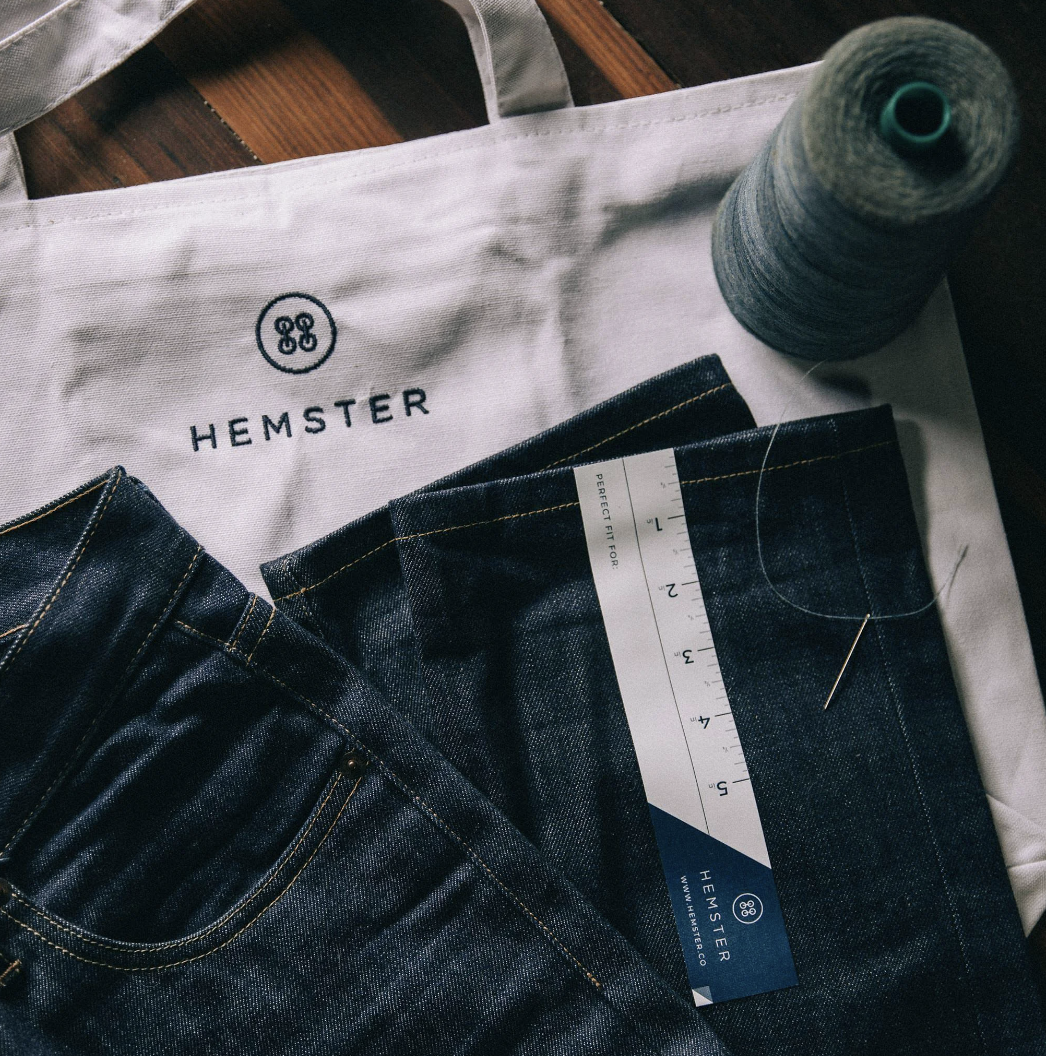
「为何与快时尚品牌无缘」
你们现在合作了多少个品牌?假如有一个Bianca品牌,成为你们的客户以后,第一步要做什么?

我们有大约30个品牌,首先我们需要看看你的衣物和库存,搞清楚我们该如何翻新这些库存,然后会启动一个试点,过程中,我们会提出,这件衣服需要清洗,那件衣服需要补充衣料,总之就是找到以最低成本修复衣服的最佳方法。然后我们建立一个模型,上面会显示,对于Bianca这个品牌的衣服,应该用这几种方式来翻新,以达到利润目标。然后我们会去测试市场,在eBay、poshmark等二手市场进行数据整合,这样就能知道从消费者或是二手买家那里获得什么样的利润。
有了这些收集到的数据,我们会告诉你,接下来的12个月里,你每个月大约能赚到多少钱。我们通常需要90天的时间来完成试,那么一旦开始运作,你只要把库存衣服寄给我们就行了。然后我们会给你建一个仪表盘,告诉你,我们到目前为止已经修复5万件了,这么做你省了多少二氧化碳,也相当于是提供给你一个ESG的报表。

看来为时尚公司创造利润是非常重要的,那这是否意味着只有这些高端和中端品牌选择你们的服务才有意义?或者说,出于经济原因,H&M这样的公司并不会有跟你们合作的意愿?
我认为投资回报率绝对是最关键的,但这里也有两面性。一个是,如果品牌能在生产环节上多投入一点,让衣服更耐用,质量更好,那么是的,品牌也希望尽可能延长衣服的使用寿命。我们关注的也的确是那些想让自己的产品尽可能长寿的品牌,那么有时价格确实是一个很好的判断标准,但通常情况下,比如Quince,是我们非常棒的品牌合作伙伴之一,他们的毛衣也只有50美元左右,但他们同样希望自己品牌的毛衣能穿得更久一点,所以我认为品牌本身的理念更重要,如果品牌本身对这个理念不买账,那么我能为他们提供多少财务回报,也就无关紧要了。
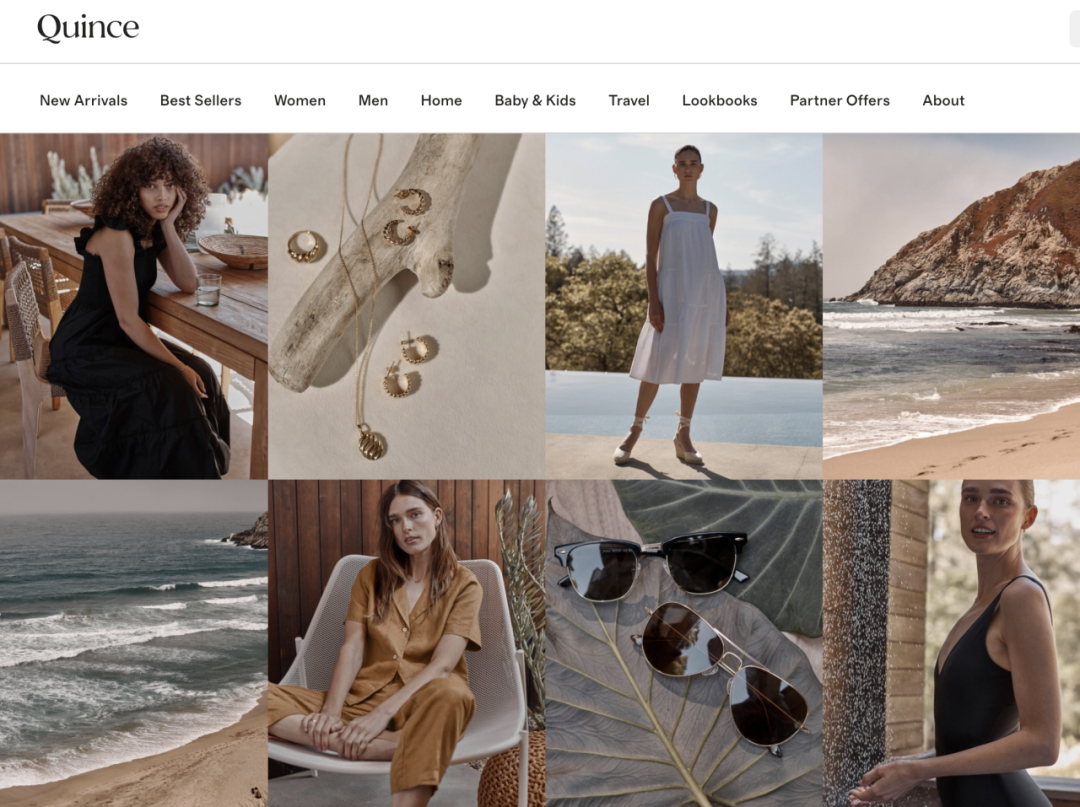
「新时代裁缝都是这么工作的」
不同的衣服有不同的问题,你们是如何解决所有不同问题的?
比如说,羊绒衣服和棉质衣服,它们的翻新方式是不同的。那么我们会去找不同的供应商来解决特定的问题。品牌和供应商之间需要我们这样的中间层,比如,品牌那里有10,000件衣服需要加亮片,10,000件需要清洁,那么我们在仓库里分类时,就会为它们找到非常擅长这件事的供应商来解决问题。
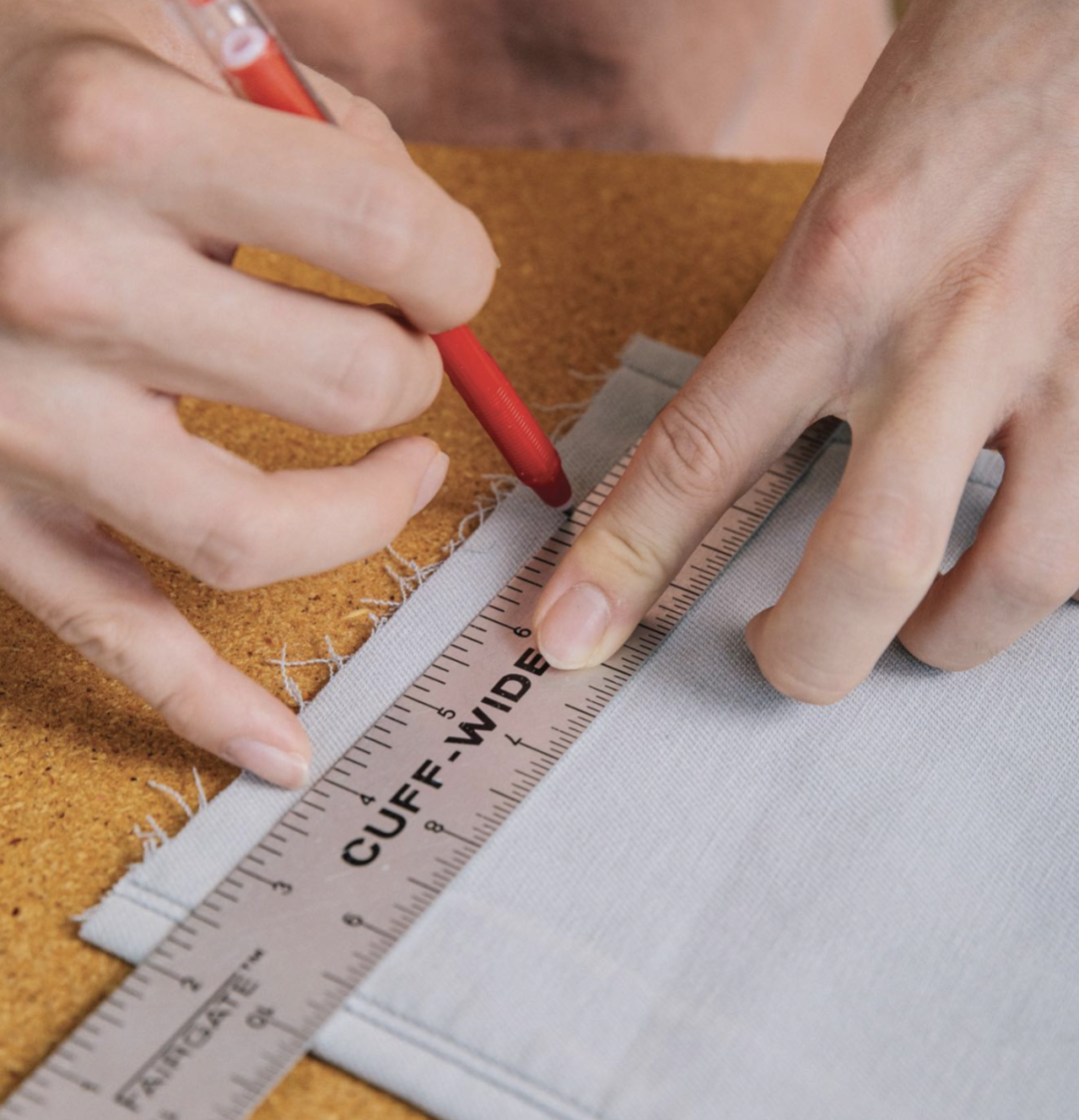
我明白了。所以你们自己不直接雇人,而是用到不同的供应商对吧?
对,我们只是把各个环节连接起来,确保一个问题的背后有足够多的人来解决,让品牌觉得合作顺畅。因为对品牌来说,最大的挑战是,它们可能负担不起每件50美元的翻新费,那么我们Hemster要做的是,确保衣服的翻新成本符合品牌的财务预测。所以必须有一个我们这样的第三方,来确保这个过程总是会为品牌带来利润。这就是数据驱动发挥作用的地方了,我们能够确保合作品牌得到的回报,是翻新费用的至少5倍。
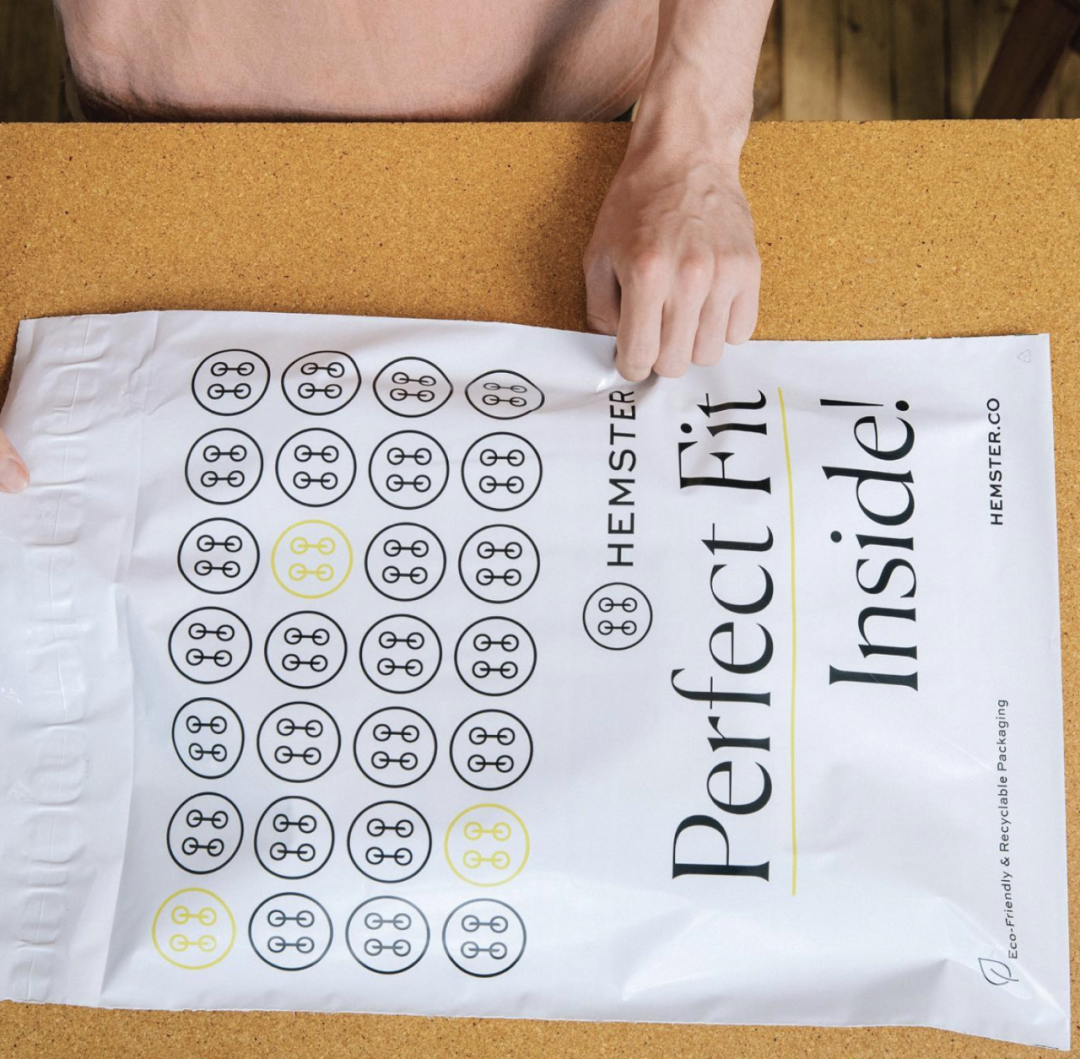
「时尚圈喜欢扔衣服 是被政策“宠”坏了?」
你们客户的反馈怎么样?他们真的能从这种服务中赚钱吗?
是的,他们不仅能做到收支平衡,有的甚至试点还没结束就已经拿到利润了。而且我们给到他们的ESG报表,也让他们感觉良好,因为他们发现自己可以从垃圾填埋场里转移走这么多衣服。这样不仅做到了政府政策的合规,也可以跟品牌的投资人或者利益相关人群做ESG报告,那这些是我们即将在今年第二季度和第三季度推出的增值服务。

「如何在老行业里发现新商机」
为什么时尚品牌才开始考虑这个问题?
很多时候品牌可以核销他们的损失。如果这些衣服成为废品,他们实际上可以通过税务核销从政府那里拿回成本,这样他们就不会觉得这是一种财务负担。虽然我只是扔掉了11%的商品,但我还是拿到了很多美元。没有太多的激励效应,那我干嘛还要修理它?因为,保险在给品牌付钱,政府也在给品牌付钱。所以从财政上来说,这还不足以让品牌们优先考虑这个项目。
但在过去的三年里,当供应链对品牌来说变得很难管理时,这一点才变得更加重要。过去,一批衣服成为废品,我可以从我的制造商或工厂重新订购目录,几周内就会送来,但在新冠疫情期间,品牌很难以过去的方式管理库存,就算可以重新订购,也要六到八个月才能寄送回来,那个时候就已经过季了,这个库存损失就大了,这时候品牌才看到,必须把库存数字化的重要性。必须了解,是什么造成了衣服受损,应不应该翻新,应该怎样翻新,总之要尽力让旧衣服重新回到销售区,才能减少损失。
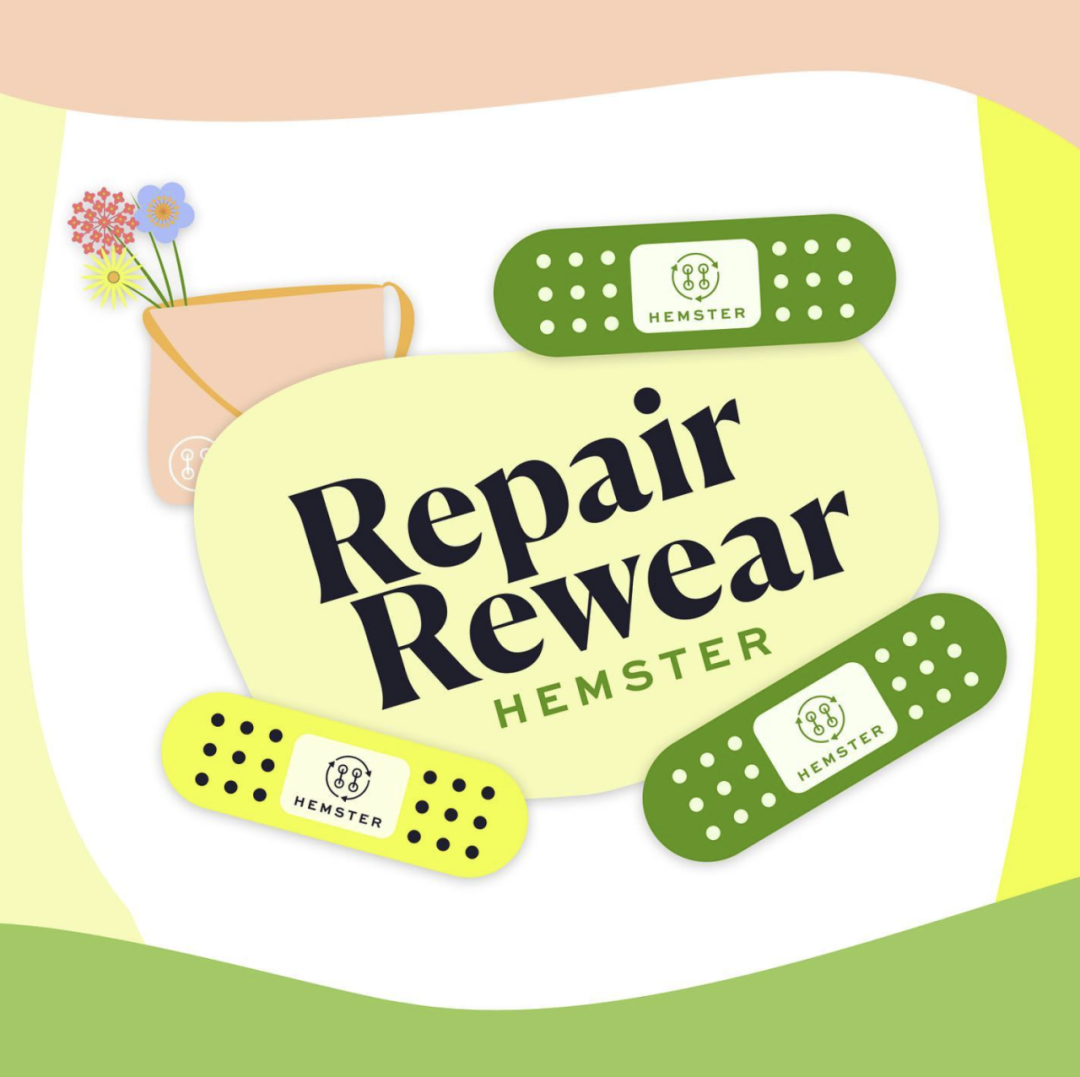
「翻新衣时尚:怎样让消费者爱上官方“二手”」
那么消费者对这些翻新衣服的态度怎么样?大家愿意买吗?
当然,我们希望让消费者多考虑这些问题:我的退货去了哪里,试用去了哪里,或者商店的样品又去了哪里?所以我想把故事讲出来,消费者会知道,他买的这件衣服,原本在纽约soho商店,但是出了一点问题,Hemster又给翻新好了,那么现在你买去了这件衣服,实际上是从垃圾填埋场转移走了一件库存。消费者对这样的故事非常感兴趣,我们也看到了相当高的复购率。因为对他们来说,这跟买新的没什么区别,但我拿到了折扣,买了我喜欢的品牌。未来我们希望可以整合更多的销售渠道,把很多原本在eBay或者poshmark等二手平台上的商品,把它带回到像布鲁明戴尔或诺德斯特龙这样的普通零售商那里。因为他们不是二手,而是翻新,当然售价会有一些折扣,这也将是我们明年和后年的战略。
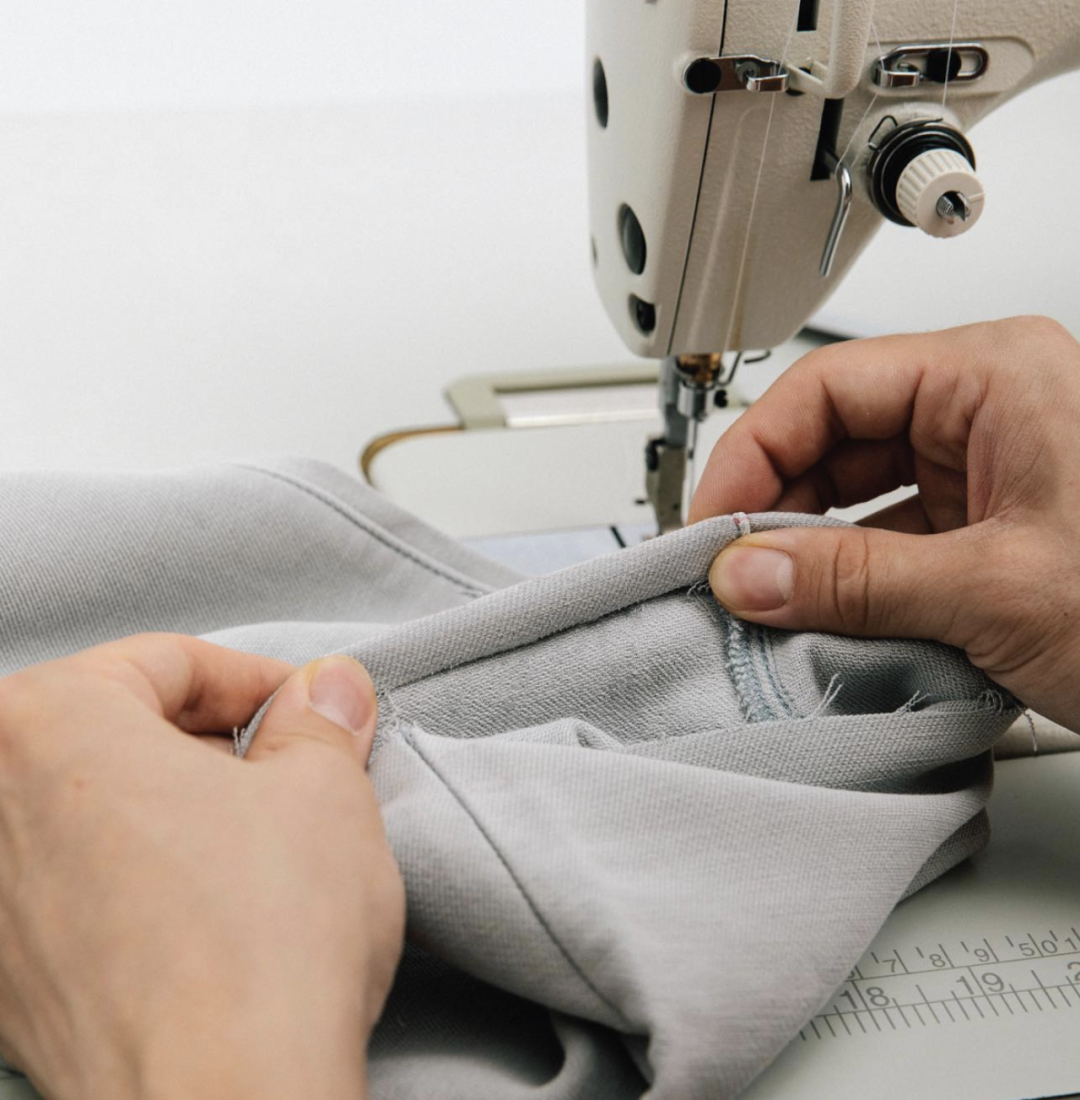
作为创始人,你进入这个行业后有什么观察和体会?
我发现谈到可持续,大家都急于寻找灵丹妙药,希望可以解决所有的问题。但至少在时尚行业,没有这样的解决方案,更多时候我们需要的是每个人迈出一小步,而不是期待速战速成。我理解大家的压力,2030转眼就到了,那个时候会怎么样?但真正的变化来自一点一点的努力。有的时候我们客户希望找到能够涵盖整个供应链的解决方案,但这是不存在的,为什么不从旧衣翻新开始呢?
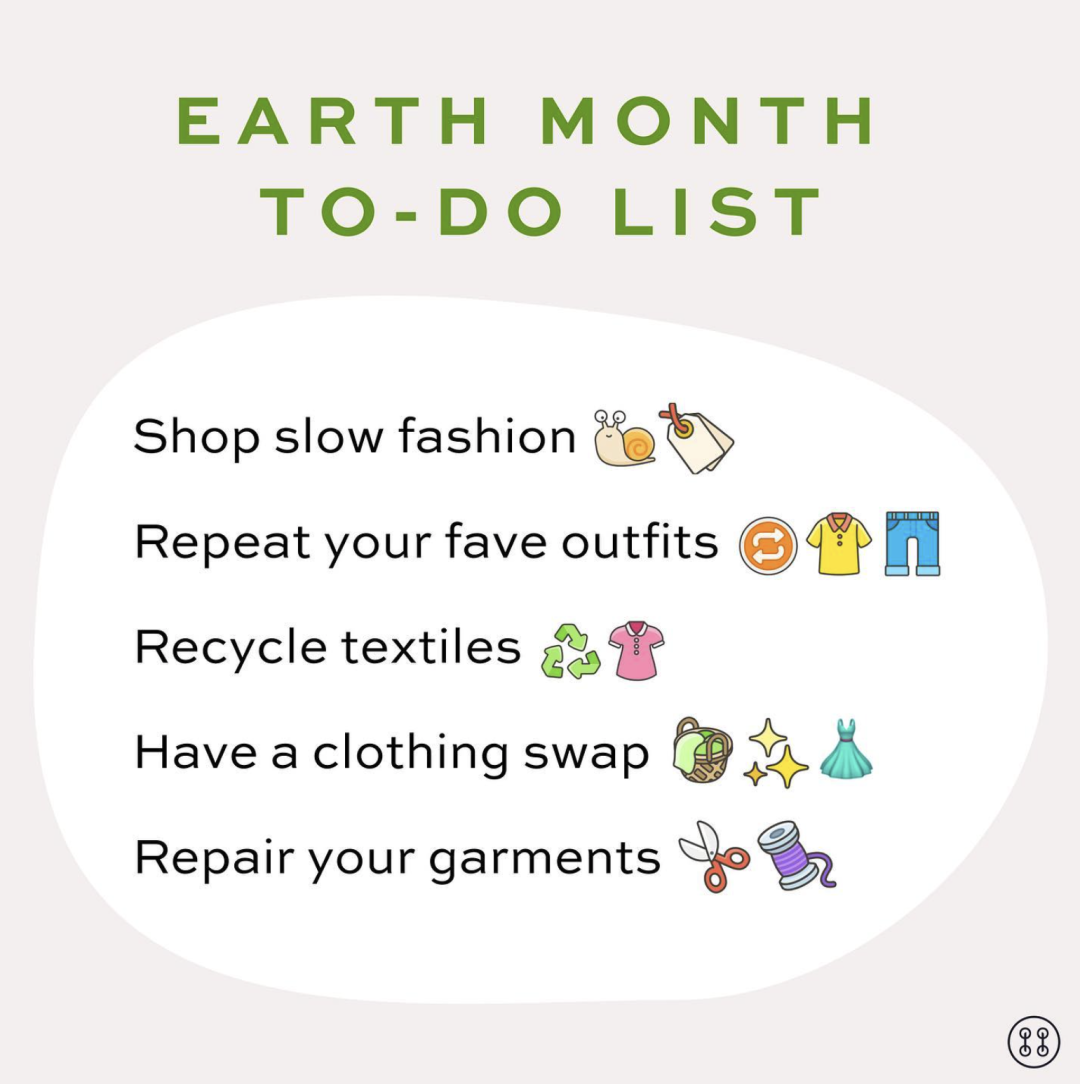
英文原文:
Bianca: So can you tell us a little bit how much waste the garment industry produces every year?
Allison: It's really crazy because every part of like the fashion, including manufacturing, design, it's a bit prone to, unnecessary, like damages. So let's say like, for example, you know, you imagine somebody cutting, a pattern out of like, a fabric, but like the leftover fabric cannot be used for anything else. So like, all those scraps basically turn into, unnecessary damages. But I think the offense gets even bigger when the units are actually done being manufactured. So let's say like fully manufactured dress, you know, when we've already admitted like a ton of CO2 and water usage and all of that stuff goes into the distribution centers. And, as you're buying something and you're trying something on the stores or you've bought it from online and returning it, a lot of those manufactured units actually become unsellable. Throughout it's like selling journey through. The studies are finding that about 11% of the fully manufactured items actually end up in landfill prematurely and prematurely means that it's really, going straight from the factory into the landfill because of very minor damages it's uncovered throughout the distribution process.
Bianca:What will happen to these wasted fashion items?
Allison: There are probably four different ways like the brands can try to deal with this currently. So you can try to recycle it. And because a lot of these units are probably synthetic, you can't really recycle fiber to fiber anyway. So when you, you know, talk about recycling for especially for garments, it really means shredding. It's not recovered as clothing. So that's like the biggest, that's rather like the easiest way for someone to deal with that. And then the other side is they're like, oh, I'm going to donate this. But if you're donating damaged unit that's not wearable, then all those got all those units right. Like when it gets received by the donation center, it gets thrown away like they don't have resources to repair it. So it's really glorified way of saying like, well, someone else can look at this and that if it's not, you know, usable, I'm going to throw this away. And then if the brand is, let's say, somewhat more luxury and they really care about the brand equity and they don't want to flood the market with this like second hand, like in quality items, then some brands really decide to sort of destroy this and damage it even further on their factory floor. And then the fourth and the most common for ready wear is you sell it to a importer offshore. And that's, what's being hidden on the brand's PNL as a revenue market revenue line item, even though they're really selling at a loss. So there is a bulk liquidation option, especially to offshore buyers. And that's when, all of the units will go to somewhere like Kenya, but no one is really recycling them nor wearing them. It just gets into this like mountain of like secondhand apparel, basically. And I think that's where a lot of the, you know, developing countries are now saying, like, we don't want to import these units anymore because we don't have a place to put this either.
Bianca:What kind of environmental impact do these garments or secondhand clothes make?
Allison: These, like, you know, huge mountains. And those are just like tons and tons of landfill that should have been diverted from the get go, but basically ending up in landfill. And they're not made to be biodegradable either.
Bianca:I know you are the person who wants to solve the problem and that's why you started Hemster, tell me a little bit what kind of solution you are trying to provide to the market?
Allison:So when we looked at this problem, I think there's two separate like separate challenges. So number one is like the brands and warehouses don't understand what's in their damage boxes at all because again nothing is digitized. So we decided to empower them with a digitization tool that's sort of AI powered, meaning like all you have to do is you don't have to be trained in inspection or anything like that. Any worker in their warehouse can start taking pictures of the unit with our, hamster app. And our app will basically like image recognize exactly what is wrong for this unit by comparing this to a stock photo. So we're say something like, oh, the stock photo seems to have a belt, but this one doesn't have a built. Where the brands are having trouble. Is, is it worth it for me to like incur additional cost to fix it? So that's like the AI logic tree that we're building in terms of like, okay, what is your mSRP of this unit? So you're supposed to sell this for $200, but now it's off season of this unit. So it's going to get 30% discount. And then we're gonna have to sell it on Poshmark. So it's on the additional 20% discount. So I can sort of calculate the selling price of this unit from the get go. And I compare that to how much will this unit cost the brand for it to be a sellable quality again. So only when the margins make sense, we go ahead and basically perform the services. And by doing that we're protecting the brands margin. And the craziest part is, even with the very strict budget, per unit, about 92% of the items we get totally gets pre-approved. Meaning these are so minor damages, it's not gonna cost brands like 30 or $40 to get a refurbished back to sellable goods. It's actually around like the low teens. So we actually understood that refurbishing has to deliver real profit back to the brand. And that's like that has been the biggest challenge with the sustainability, you know, committees and fashion brands because it's usually a cost center. But we really try hard to make it into a profit center.
Bianca:So, for example, I have a company called Bianca's Clothes, and my company wants to work with hemster. Tell us what's going to really happen.
Allison: We're using our basically they're using him to revive ads, their monthly disposition on channels. So normally the brands will be sitting on on a backlog. So they're like, oh, I was going to do a sample sale or I was going to donate this, but that usually becomes our pilot because we need to look at your unit and your skill library and understand, like, oh, how would we refurbish these things? So we build out ownership throughout the pilot and that's where we understand, like, okay, we're going to try cleaning this way. We're going to try to clean that way and offer your fabric. This is actually like the best way to do this, to get it back to the highest quality at the lowest cost. So that's where we build out with this like AI model of like okay, so for Bianca's clothes, we should be cleaning these waste so that we can hit your margin goals. And then we'll actually test out, our hamster marketplace, which is like our integration with eBay, Poshmark, Vestiaire, Depop, where the refurbished goods can go to the secondary market and see what kind of like ASP that you can garner from your customers or from like the second and buyers. So with those data sets collected, that's when we go into like, okay, this is how this disposition channel is going to look for you for the next 12 months. And we can give you a quite accurate like forecast of, like if you send me all your damages, you're actually going to be making, let's say, $50,000 every month or $75,000 every month. And that's where we can, like, really give you, accurate like look into, how you should be expecting our ROI coming in. So that usually takes probably like 90 days for us to go through the pilot and then go through this, like, evergreen conversation. And then once the evergreen starts, it's super easy. You're basically saying like, okay, I'm going to get my office manager to basically use your address instead of sending it to a recycle or sending it to a donation. So it's as easy as like, here's our address, just send it to us, and then we will build you a dashboard that shows you, hey, we got 50, you know, like thousand units so far. This is the landfill that you diverted. This is a CO2 that use a cluster. So like we build you this like ESG dashboard as well.
Bianca:You're showing me how to make this profitable for these fashion brands. And why do you think this is so important? And also does that mean? It only makes sense for a certain kind of mid range or higher range priced fashion kind of brands to do this? Maybe because of economic reasons like H&M or these kinds of low price brands, there is less incentive for them to do this?
Allison: I think the ROI is definitely the strongest. Like the higher, you know, like the selling prices for that unit. But I actually think there's two sides to it. It's one is. If the brands can sort of like invest a little bit more in there, like individual manufactured units for it to be like durable and quality driven, hence a little bit more expensive then. Yeah. Like you should want to keep this like alive for as long as possible. So I think we are looking at brands who are interested in making their manufactured products last as long as possible, and sometimes the pricing is a good correlation to it. But it's usually like even, you know, let's say Quince is one of our really amazing on brand partners, but their sweaters are $50, but they're still interested in like, hey, I want to make sure my sweaters can live as long as possible. And I think that comes more from the brand ethos unless from the financial margin side. I think the biggest thing is like our brand buying into this mission of like, hey, I want to make sure every single unit I produce is under my responsibility, and I want to make sure it last as long as possible. And if those brands are not buying into it, then it doesn't matter what financial returns that I can like provide for them to.
Bianca:And how about the people repairing these clothes like, you know, different clothes have different problem?
Allison:So I would see the services as like a modular pieces that I can plug into our operational models. If we look at the material and look at the damage type. So we're like, okay, cashmere pulls, that's a different repair needs than cotton poles. So individual vendors that we find were really good at this specific thing. So what you need is this like translation layer between the brand and these like individual artisans of like, hey, I have 10,000 units coming in from the sequins, but 500 of them need 10,000 of them needs cleaning, blah, blah, blah. So like we sorted at our warehouse and then we find the vendors and artisans who are very good at that specific thing.
Bianca:So you don’t hire people yourself, you just find the right person to refurbish.
Allison:Right. It's just connecting the dots of making sure like, oh, I see a lump here. And then there's like enough people, but it's very fragmented. So like, how do you make sure they are coming together to play well and also making sure like the brand feels good about it because the biggest challenge is they're like, I cannot afford to spend $50 on this. Will you just really, really make sure that the per unit cost meets my financial forecast? So there has to be additional layer of like, okay, who is making sure that this process will always generate profit for brands? And that's like the data driven guardrails that we're building around this refurbishing, flow to make sure like, hey, like I know that I can generate at least five x on whatever you're spending on this. So I think those three things like have to come together and the really old new way to like make it work is like through tech and through data science.
Bianca:So you have been working with 30 brands. It's a big number. Tell me more about what's going on with these brand. What kind of feedback are you seeing? And I'm really curious, are they really making money out of this?
Allison:What we see as they are, they break even and start generating profit even after the pilot. And, you know, I think in addition to like just just, you know, like, a cool, like a cash like profit that we're generating. But I think the next phase of this is going to be a lot around, like looking at the ESG metrics that we're able to provide back to the brands and kind of comparing that to the policies that's coming down the pike, because I think they understand, like, of course it feels good for them to be like, oh, wow. Like I diverted so much of landfill through this program. But how does this compare to the compliance that I'm supposed to, like, follow as a brand? And I think that's sort of like the last piece that we're starting to, look at is here are all the amazing results that we're able to deliver because you're refurbishing over doing anything else, and because you're doing this, you actually qualify and you're meeting all these compliance, requirements from like, the government or even like for your investors, like, how do you report it back to, the right stakeholders so that you know that you're following the right rules. So that will be kind of like the value added services that we're launching, for Q2, Q3, like this year.
Bianca:Why do you think the brand just started to think about this type of thing?
Allison:A lot of the times the brand can write off their damages. So like if the units are damaged, they actually get their cogs back from the government through the tax write offs. So there's a lot of financial, vehicles that they can utilize so that they're not really feeling this like financial burden of like, oh my gosh, I. Basically just threw away 11% of my merchandise. But I'm getting a lot of the dollars back, so there isn't a lot of incentive around. Why should I fix it? Because, you know, the insurance is covering it. The government is covering it. So financially it was not enough burden for the brands to like, want to prioritize this. And it only became more important. And maybe like in the last three years when the supply chain became really difficult for the brands to manage, because before you could say, oh my gosh, 11% got damaged, but I can just reorder my catalog from my manufacturer or my factory that it will get here within weeks. But during Covid, it became really difficult for brands manage their inventory that way because they would reorder and then that category would for that catalog would not, arrive back into distribution centers for like 6 to 8 months, which means they've already lost that season. So they're like, oh, no. Like I actually can't afford to just like damage out these inventory left and right because I might not get a chance to replenish this down the line. I think the brands are finally seeing like, I need to at least digitize what's going on during my damage process. So I understand, like what's contributing to the damages. And are these actually supposed to get damaged out, or should they, try to get like service and repair it and clean and try to stay in the circularity? You know, like market for a bit longer.
Bianca:We're talking about the fashion companies' side. Now let's talk about the consumer side. What consumers' attitude towards these repaired clothes.
Allison:Yeah for sure. And I think on that really a big like marketing and conversations that we want to spark like within the consumers too of like thinking about where does your returns go. Where does your store trials go. Where do these displayed units go? Like these units all have to find a home at the end of the day. So I think telling the story of like, oh, did you know that this thing came from Soho store and then was damaged and then came to us that we fixed it, and now it's in your hands. And by buying this unit, you actually saved this landfill. I think telling the story is really intriguing and exciting for the consumers. And we actually see a pretty high repurchase rate across our audience already because they're like, oh, the quality is basically like new, but I get to purchase at a discount from the brands that I love. So hopefully, like the consumers themselves can see this as like a win as well.
Bianca:Do you have any new discoveries since you started Hamster?
Allison:This category, like, just doesn't even exist right now. Like, there's a lot of refurbish, like electronics or like hard goods like that, but. No one has really tried to create like a refurbished soft goods market. I think the closest anyone got is maybe like with Nike, with their refurbished, like, shoes and sneakers, program, but with apparel, like, no one has really created this market before. So obviously, you know, like I'm very hopeful and very optimistic. Yeah. So I think, you know, ever since we sort of, like, went head into the sustainability world, one thing that I find over and over again is I think people are looking for potentially like a silver bullet, like this one thing that's going to solve all of their problems when it comes to like fashion industry would waste and which like, it just can't exist that way. And, you know, everyone just needs to make small steps at a time. And I think instead of like expecting really quick results. And I understand why we feel this like pressure to come up with silver bullet solution because we're like, oh my gosh, 2030 is really quick. Like it's going to come right around the corner and then what's going to happen if we hit our, you know, climate like crisis mode at that point. So I feel like everybody is operating under this like crisis mode. But really like I think the change comes from like the bite size changes first. So you know, when we offer refurbishing, sometimes we get, you know, the head of sustainability, policies like response would be like, that's amazing. But I'm looking for something that encompasses my entire supply chain. But there's like not one service that would be able to deliver that. Why don't we start here? Or why do we start with something that you can do today, and then we can build upon that, like together in the next, like 5 to 10 years? [00:00:00][0.0]
Bianca:Thanks, Alison. Thank you so much for sharing your stories and your insights.

想要收听Origin聊天室音频完整版的朋友请移步到小宇宙|Apple Podcast|网易云播客|喜马拉雅各大音频平台搜索“Origin研究所聊天室”或者“陈一佳”进行收听。如果喜欢的话,欢迎评论区和我们互动,并推荐给一两位好友!
·本栏目文章节选播客文本 部分观点仅代表嘉宾个人意见
文中未表明出处用图来源于
ins@hemsterco
版权归原作所有·
✦+

关于我们
Origin研究所
我们是一个关注于全球可持续发展、致力于倡导低碳环保生活方式和助力体现企业社会价值的社区。在这里,你将收获最新的可持续发展资讯,聆听可持续践行者的行动与故事,提升全球ESG认知。关于可持续的一切,都将在这里发生。
关于Origin可持续进化论
「Origin可持续进化论」是国内首档围绕ESG可持续发展、低碳生活与循环经济的中文播客。
每期节目,将会遇到前沿科学家、企业家、艺术家、设计师、发明家、潮流推动者和先锋实验者等等在可持续方向有影响力的人物做客,分享他们的故事和案例,探讨最先锋的可持续话题。
带你把握ESG相关的最新动态,挖掘企业的社会价值,一起寻找留住美好地球的答案与解决方案。
「Origin研究所」所长是谁呢?
主持人:陈一佳
国际财经主持人,创业小姐姐和入围过戛纳的纪录片工作者。最重要的是一个热爱环保的宝妈!热衷用各种方式和大家探索有关ESG的一切。
出品方
三橙传媒关注ESG、科技、教育、经济领域的全球发展,出品制作最前沿的纪实和新媒体内容,通过专业宣发和营销能力,带大众预见未来,协助优秀的企业和行业领袖发生,助力企业跨平台和跨区域的品牌建设。
✦+

?在哪里收听节目?
喜马拉雅 | 小宇宙 | Apple Podcast | 网易云音乐
我们将在每两周的周四中午更新播客,请锁定我们并欢迎推荐给一两位朋友
?从哪里获取更多资讯?
小红书 | 新浪微博 | 抖音 | ins
?搜索“Origin研究所”
收获更多有趣好玩的环保资讯
?如何联系我们?
商务合作请联系
project@ox3production.com
点击阅读原文,观看精彩视频!




